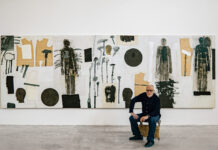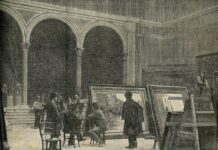Flora Yukhnowich is inspired by the legacy of Rococo. No works in Basel. Far from the spirit of Adriano Pedrosa’s Venice Biennale.
No political message on the agenda and a clear cut with Engaged Art and local epistemologies. About all this, Flora Yukhnowich, a young English artist, is inflexible. Instead, she accepted to be invited by Xavier Bray, director of the famous Wallace Collection in London, housed in a pompous palace from the second half of the 19th century. At the top of the monumental staircase leading to the main floor two works by Yukhnowich have been installed exactly where two artpieces by Boucher with pastoral subjects previously adorned the walls.
Next stop: Los Angeles at the headquarters of Hauser&Wirth. Accepting to replace two Bouchers is a courageous undertaking. Francois Boucher, Antoine Watteau and Jean-Honoré Fragonard survived neglected even after the turning point of the French Revolution.
Yukhnowich, when claims spiritual closeness and inspiration, is in tune with current uncertainties that could also be premonitory signs of a radical change.
It is no coincidence that the three French artists show political indifference even towards societies built on rights, bourgeoisie and industrial revolution. They are contemporary to at least two revolutions on the shores of the Atlantic Ocean: that of Haiti and that of the American colonies against the British Crown. The last one, the French Revolution, in their homeland, overwhelmed them. So much so that Jacques Louis David, the champion of Neoclassicism, author of Napoleon on Horseback conquering Italy, wanted to become a benefactor of Fragonard by paying him a sort of pension since he was by now a politically finished artist.
But you should say that the distancing from the category of the politician has often been condemned. The deviant Jeff Koons has used many of the colours of the Rococo palette, while John Currin has used iconic existential situations through the prism of the US Regionalism of the thirties.
Yukhnowich is in a tough polemic with the cocktail of modernism. Likely many she tends to be tied to the twentieth century in a very free way, as she were in front of a a buffet.
The normalization of the legacy of the twentieth century was not something short and easy. On German soil the first radical rejection of the national glory of the Bauhaus is due to Isa Genkzen with the exhibition titled Fuck the Bauhaus (in 2000). At the Guggenheim the exhibition Going Dark in the central rotunda with its careful attribution of percentages, male, female, black signals an attachment to the themes of recent US deconstructionist movements that have dissected the legacy of Modernism only apparently recognizing its value.
This year Barbara Kruger’s 79th birthday is celebrated. She has reused the Constructivism of the Russian artist Rodchenko for the graphics in which she inserted her sentences on women’s liberation. The neo-baroque/rococo current instead makes carnality explicit in every way and rejects curatorial activism. The growth of political movements in the USA and the secession of intellectuals have produced a great transformation since the economic crisis of 2008. Thanks to such phenomenon everything or almost everything has become tradition and heritage at free disposal.
Everything has always been ready for any strangest mixes both digital and material. The heritage is used by different artists from the South and the North of the world. But they have in common the tendency to think of it as free fruition and enjoyment. The buffet is ready.
______________________________________________________________________________________
Lontano dalla Biennale: Flora Yukhnowich si ispira all’eredità del Rococò. Nessuna opera a Basilea. Lontanissima dallo spirito della Biennale Di Adriano Pedrosa.
Nessun messaggio politico in agenda e un taglio netto con l’Arte impegnata e le epistemologie locali. Su questo Flora Yukhnowich giovane artista inglese è inflessibile, piuttosto ha accettato l’invito a esporre di Xavier Bray direttore della celebre Wallace Collection a Londra alloggiata in un palazzo pomposo del secondo Ottocento. In cima alla monumentale scala di accesso al piano nobile dove prima ornavano le pareti due Boucher con soggetto pastorale, sloggiati temporaneamente in una sala dalle pareti bianche, stanno invece due opere della Yukhnowich. Prossima tappa Los Angeles nella sede di Hauser&Wirth. Accettare di sostituire due Boucher è impresa coraggiosa. Francois Boucher, Antoine Watteau e Jean-Honoré Fragonard sono sopravvissuti negletti e trascurati dopo la svolta della Rivoluzione Francese. Poco si sono prestati o hanno ispirato il Contemporaneo.
Il posizionamento della Yukhnowich che rivendica vicinanza spirituale e ispirazione la dice lunga però sulle incertezze attuali che potrebbero anche essere segni premonitori di una svolta radicale.
Non a caso questi artisti sono depositari di una indifferenza politica che li ha estraniati dalle società costruite sui diritti, borghesia e rivoluzione industriale. I tre artisti sono contemporanei ad almeno due rivoluzioni sulle sponde dell’Oceano Atlantico, quella di Haiti e quella delle colonie americane contro la Corona Britannica. L’ultima la Rivoluzione francese, nella loro patria, li ha travolti. Tanto che Jacques Louis David il campione del Neoclassico autore del Napoleone a cavallo alla conquista dell’Italia volle diventare benefattore di Fragonard pagandogli una sorte di pensione visto che ormai era un artista politicamente finito. L’allontanamento dalla categoria del politico è stato spesso condannato. Controcorrente Jeff Koons pr ha utilizzato molti dei colori della tavolozza dei Rococò, mentre John Currin l’ha raccontato e usato con situazioni esistenziali iconiche attraverso il prisma del Regionalismo USA degli anni Trenta.
Yukhnowich è in dura polemica con il cocktail del modernismo e come molti è orientata a prelevare dal Novecento con grande libertà solo quello che le interessa e senza obblighi insomma come da un buffet imbandito. La normalizzazione dell’eredità del Novecento non è stato qualcosa di breve e agevole. Il primo radicale rifiuto in terra tedesca della gloria nazionale del Bauhaus lo si deve a Isa Genkzen con la mostra titolata Fuck the Bauhaus del 2000. Al Guggenheim la mostra Going Dark nella rotonda centrale con la sua attenta attribuzione di percentuali, maschio, femmina, black segnala un attaccamento alle tematiche dei recenti movimenti decostruzionisti USA che hanno dissezionata l’eredità del Modernismo solo apparentemente riconoscendogli valore.
Quest’anno viene festeggiato il 79 compleanno di Barbara Kruger che ha riutilizzato il Costruttivismo dell’artista russo Rodcenko per le grafiche in cui ha inserito le sue sentences sulla liberazione femminile. La corrente neo barocca/rococò esplicita invece in ogni modo carnalità e rifiuta il curatorial activism. La crescita dei movimenti politici negli USA e la secessione degli intellettuali hanno prodotto a partire dalla crisi economica del 2008 una grande trasformazione grazie in cui tutto o quasi è diventato tradizione e eredità in libera disposizione. Tutto collocato su un buffet pronto per l’uso con i mix più strani sia in digitale che in materico oppure con una lunga vita solo digitale. L’eredità è utilizzata da popoli di artisti differenti del Sud e del Nord del mondo ma uniti nel pensarla di libera fruizione e godimento Il buffet è pronto.








